The first stop on my road trip was the rookie-level Global Mazda Cup series, and my, how the landscape has changed since I joined iRacing almost eight years ago.
When I was a rookie, the lowest-level car was the Pontiac Solstice. Playfully if somewhat derisively nicknamed the “Slowstice”, it was a former SCCA touring car whose real-world shelf life expired not long into its iRacing tenure.
Its purpose, it seemed, was to provide a functional introduction to driving on the low end of the speedometer before ushering drivers onto the next rung of the ladder. To be sure, the rookie schedule rotated between just two tracks — Lime Rock and Laguna Seca — and even iRacing’s co-founder, John Henry, notably said that “as a rookie, your goal is to get out of rookie”.
These days, the rookie schedule features a greater number of tracks — all free content — and the rookie car has changed to the more attractive Mazda MX-5 Cup and, most recently, the Global MX-5 that was designed by Mazda with input from the iRacing simulator.
Those changes have made the rookie Mazda Cup series a destination rather than a stop-over, and that’s likely to be even more true this season. The top 20 drivers in points will have the chance to apply and qualify for a Mazda racing scholarship, which should help iRacing’s most popular road series draw in even more drivers.
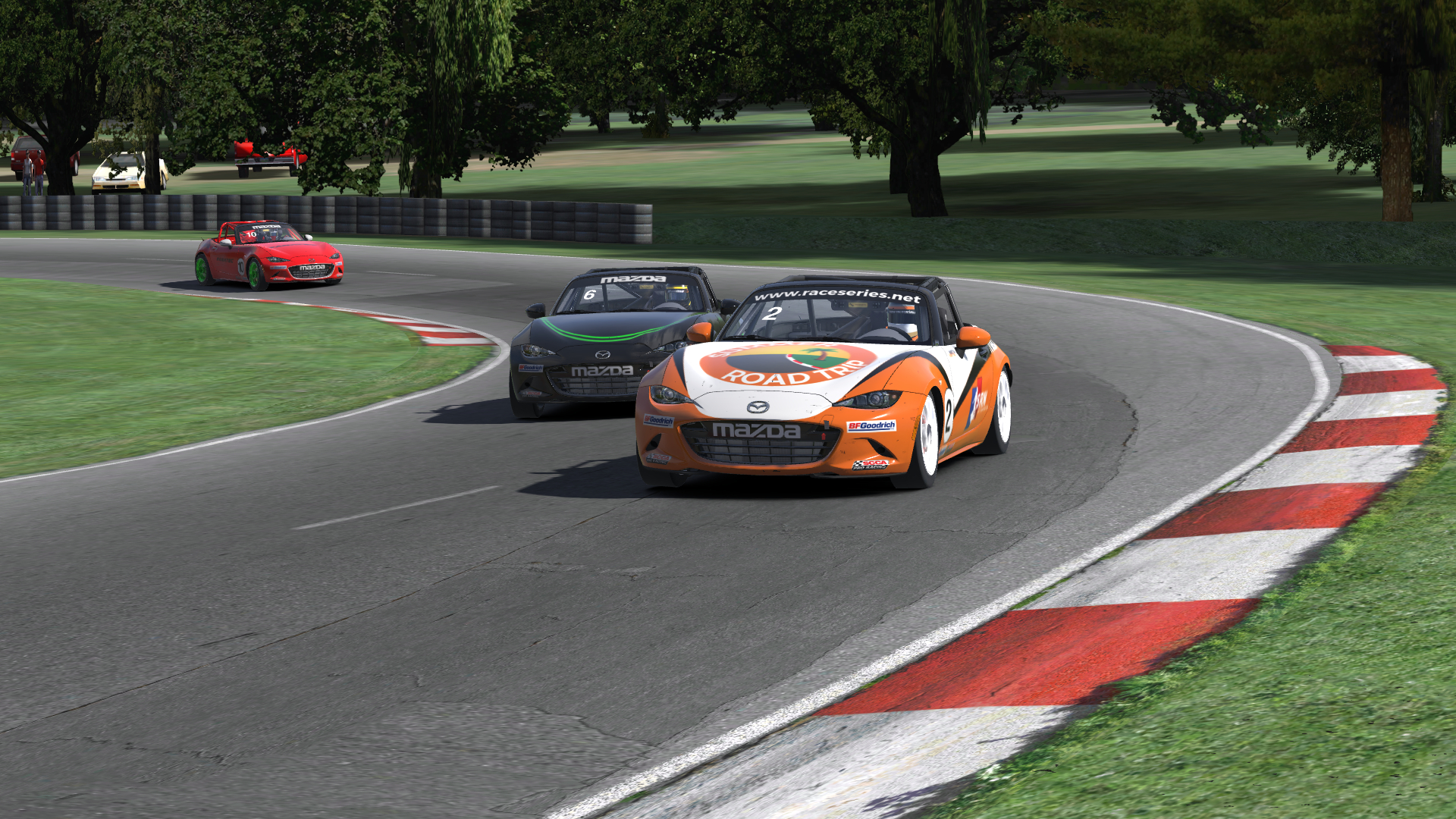
Close racing through the esses at Summit Point.
The Shakedown
While I had some experience driving the old MX-5 Cup car, I hadn’t run more than a couple laps in the new Global MX-5 since it came out last year. All in all, it’s a solid car that should appeal to rookies and veterans alike.
Although its acceleration leaves a little to be desired for speed demons, it’s great under brakes and in the corners, which you’d expect from a lightweight roadster.
In that sense, it reminds me of my real-world car: a Honda S2000, which I drove on the track at VIR last year. The back end sometimes feels light while cornering due to the lack of downforce, but it still feels responsive and connected to the road.
Because of that, it’s relatively easy — and fun — to drive, but tough to consistently drive fast. Pushing the limits may not result in spins as with some higher-level cars, but it can lead to minor mistakes and small but costly time losses.
Another bonus for rookies is that the series uses a fixed setup, and a solid one at that. Rather than searching for setups and tuning on them, drivers can simply hit the track and get ready to go for one of the races that kicks off each hour — the essence of arrive-and-drive racing.
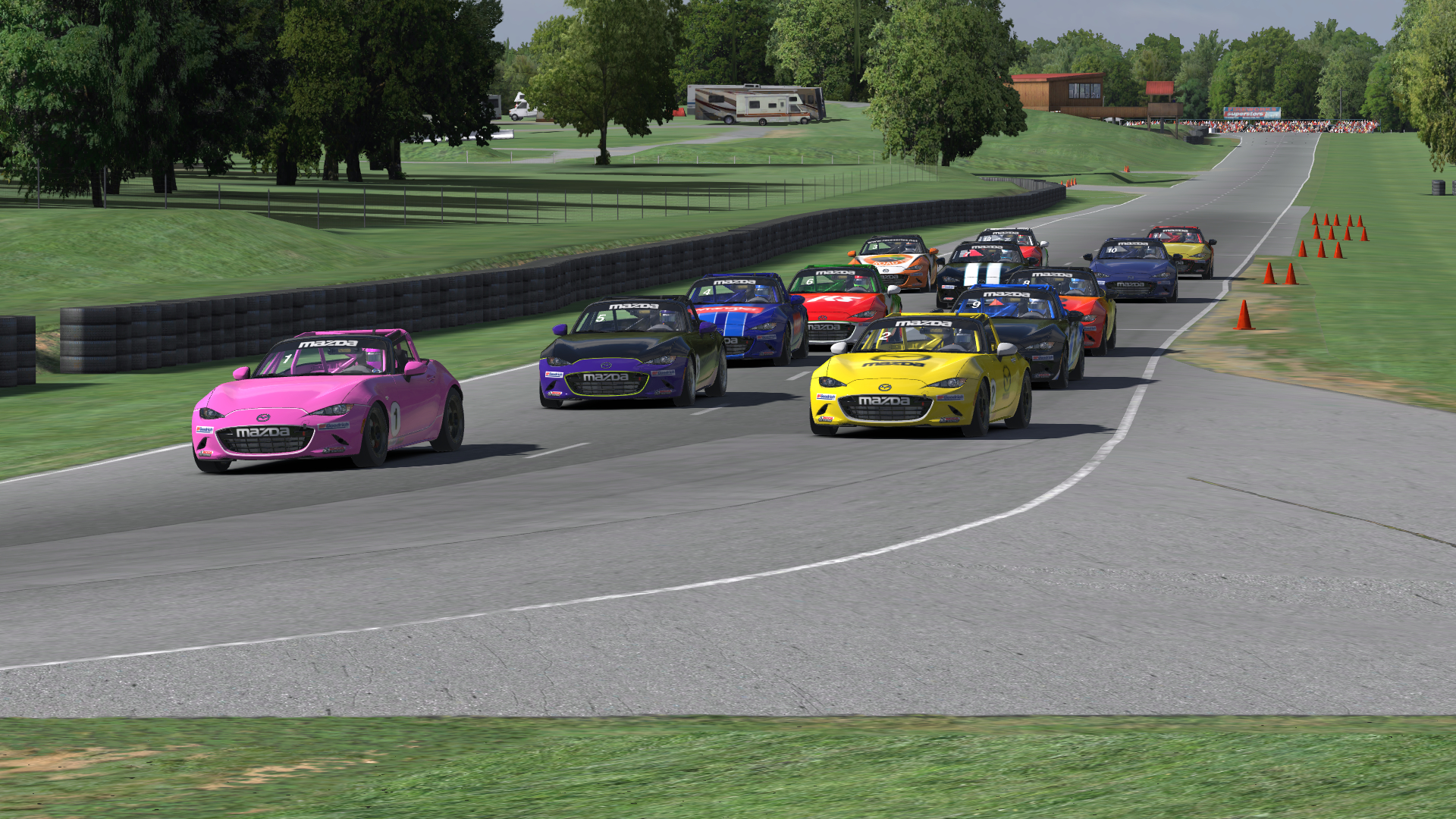
A field of Mazdas heads into turn one at Summit Point.
A Bumpy Start
That’s essentially what my preparations amounted to. I was out of town for most of the first week of the season, and when I got back on Sunday afternoon, I was eager to get behind the wheel.
Although I had only a few dozen laps of total practice in the Mazda around the Summit Point track and no experience driving around other cars, I registered anyway for a popular afternoon timeslot that had nine total splits of drivers.
Even in qualifying, I got a taste of the competition in this series. My lap of a 1:22.316 put me ninth on the grid, yet I was just three tenths away from fourth place.
The small grids of just 12 cars add to the sense of closeness. Even from near the back of the grid, I could see the leaders in the early laps of the race. However, knowing I couldn’t make up those positions all at once, I decided to hang back and wait for the drivers ahead of me to make mistakes.
Despite my patience, I was an innocent victim of the first major mistake ahead of me on lap three. With most of the field still packed together like sardines, one car spun entering the tight turn five. As he rolled back onto the track, the cars behind him ran wide to avoid.
Although I spotted his spinning car and headed for the other side of the track, the car to my inside drifted into me and spun me out. However, my car was undamaged, so I looped it back around and kept going, having lost only one position from where I started.
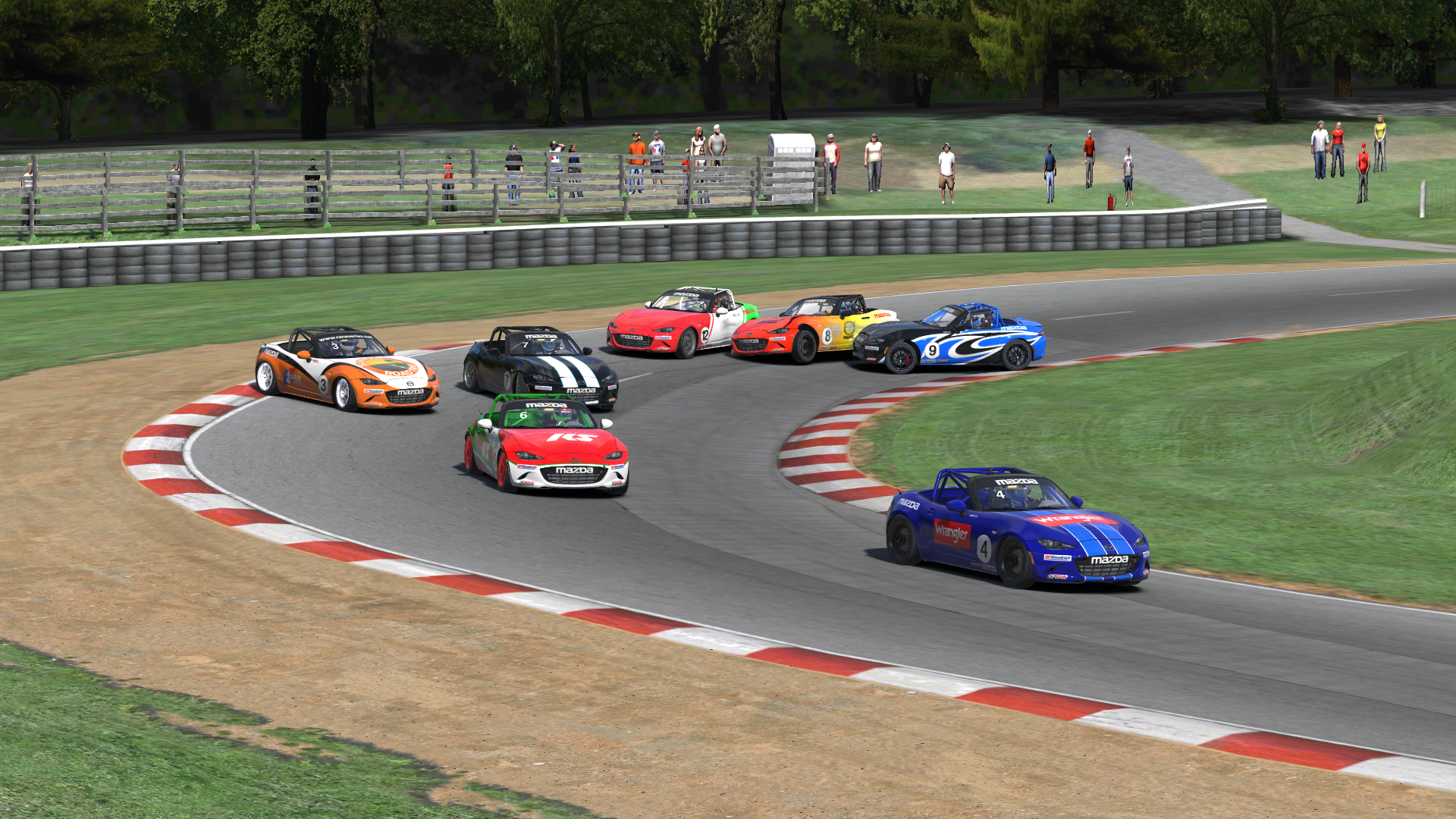
An early incident creates chaos in the back of the field.
The Battle Begins
By then, the lead pack was more than 10 seconds up the road, so my race became a one-on-one battle with the driver who unintentionally spun me while avoiding the wreck. He did have damage but expertly defended his position — another good skill for rookies to learn in the Mazda — which made him tough to pass.
While dirty air or aero push isn’t really a problem in the low-downforce Mazda, a lack of visibility when following another car can make it tough to set up passes. With just a few laps to go, I ran a little wide entering the final corner since I couldn’t see the edge of the road.
After clipping the dirt, I drifted through the corner and lost valuable time but kept the car pointed straight — a great example of how you can recover from mistakes in this car.
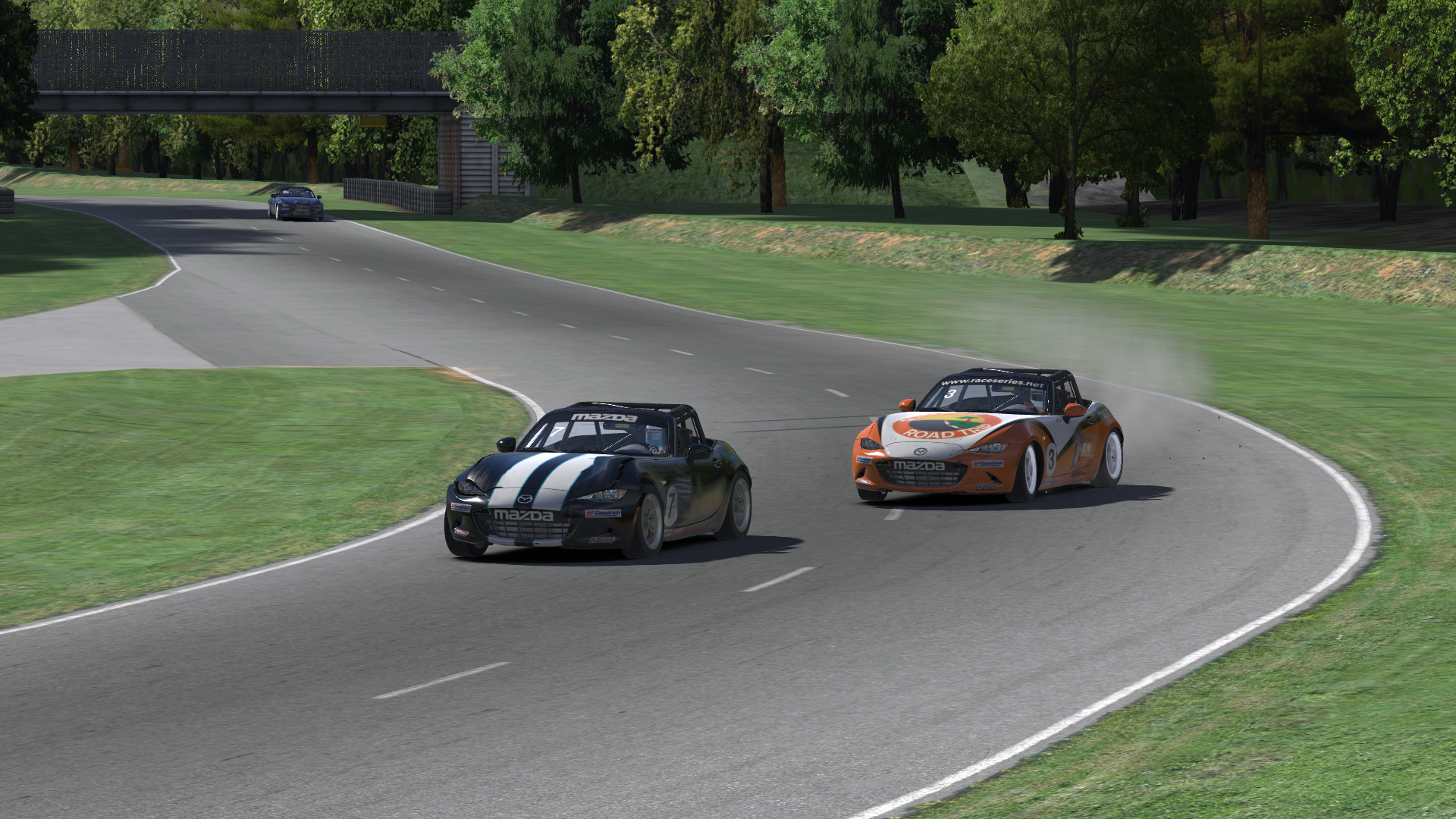
Drifting through the final corner, loose gravel in tow.
By the time we took the white flag, I had closed back onto the bumper of the car ahead of me and I had a run entering the turn one hairpin. He defended the inside line while I braked late on the outside.
We were side by side going through the corner and he slid slightly wide, making light contact with my car. It was a minor faux pas, but nothing inexcusable at that stage of the race.
With the best passing zone on the track behind us, I was forced to ride behind him until the finish. That put me in seventh place — better than where I’d started, but somewhat disappointing given my early spin and inability to make the pass toward the end.
Global Mazda Cup - Race 1
Sunday, June 18 at 4:00 pm EDT • Strength of Field: 3331| Finish | Start | Interval | Laps Led | Fastest Lap | Incidents | Points | iRating | Safety Rating |
|---|---|---|---|---|---|---|---|---|
| 7 | 9 | -22.432 sec. | 0 | 1:22.232 | 7 | 85 | 4487 (-33) | A 4.46 (-0.29) |
Role Reversal
I waited a few hours before taking to the track again. While the field wasn’t quite as strong for my second race, it still had plenty of tough competition.
I qualified in third and realized that the top two cars would be nearly impossible to beat based on their pace — half a second quicker than me in qualifying. So I hoped to have a clean race and hold onto a position on the podium.
That goal lasted all of about 100 yards. I got a slow start, which let two cars get to my outside and pass me by the exit of turn one. I then entered a back-and-forth battle with the driver ahead of me, who qualified in sixth.
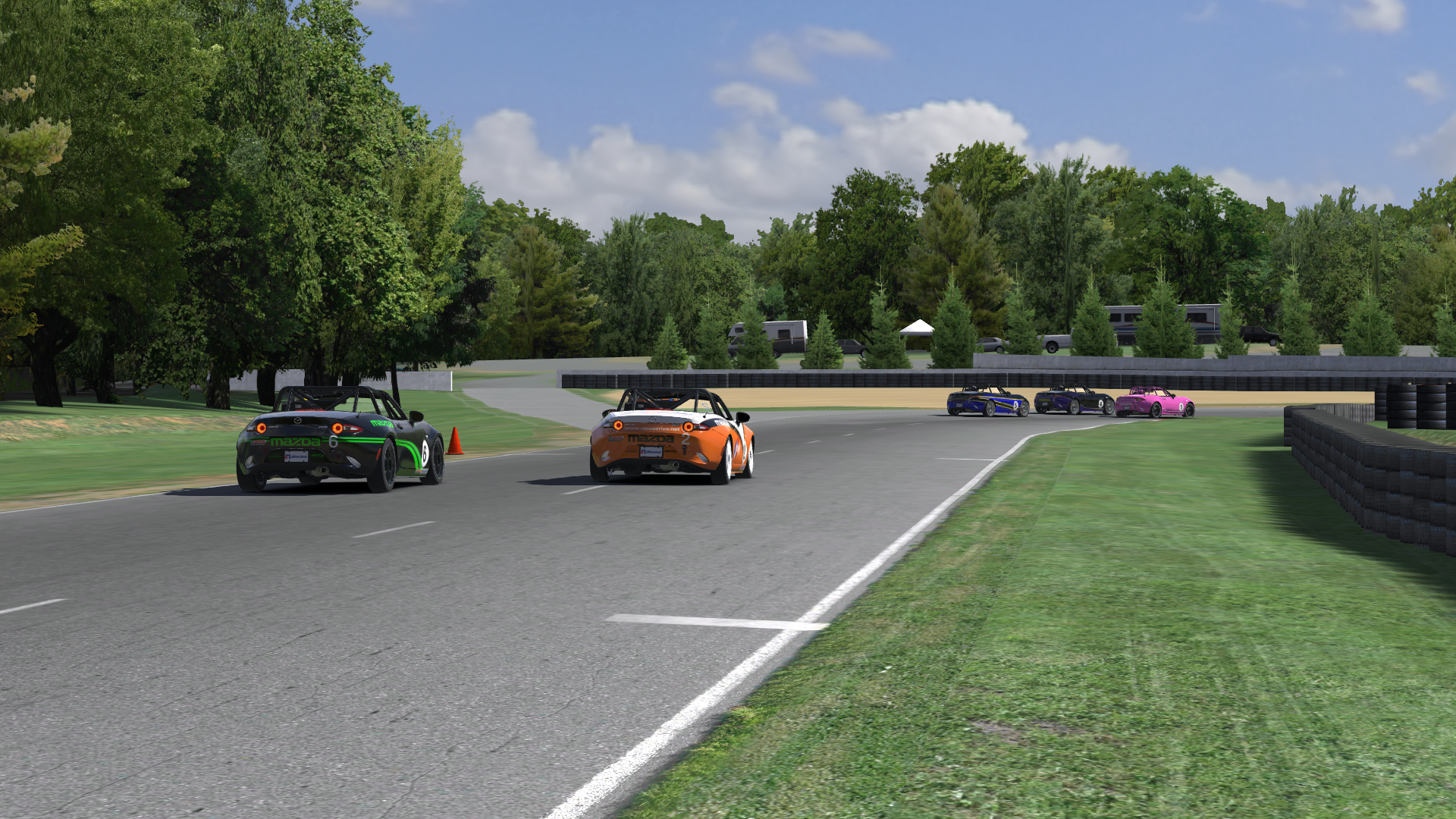
Making a pass entering turn one while the leaders pull away.
By the time I got back around him, the three leaders had a draft-proof gap over me, so for this race, I was forced to play defense — mirror-driving and anticipating moves instead of executing pass attempts of my own.
As the laps wound down, my advantage stood at a second and a half, but the pressure was still there, and it began to affect my driving. In just over a lap, I ran wide through turn one, missed a shift entering turn five, and had a slow run through the esses. By that point, the car behind was less than half a second away and easily in my draft.
Although I continued to lose time through the esses — consistently my worst section of the track — I gained some back through the critical final corner and managed to keep my opponent far enough back that he couldn’t make a move entering turn one. That kept my fourth position safe until the finish.
Global Mazda Cup - Race 2
Sunday, June 18 at 8:00 pm EDT • Strength of Field: 2714| Finish | Start | Interval | Laps Led | Fastest Lap | Incidents | Points | iRating | Safety Rating |
|---|---|---|---|---|---|---|---|---|
| 4 | 3 | -5.287 sec. | 0 | 1:22.261 | 6 | 112 | 4491 (+4) | A 4.27 (-0.19) |
The Week in Review
I certainly took some positives from my two races. For one, I made it to the finish in both, and despite being spun in the first one, neither race was the sort of slaughterhouse you sometimes expect from a low-level series.
A few mistakes notwithstanding, I was also pleased with my racecraft, especially having never driven this car in traffic or in battles for position. One of my biggest fears entering this Summer Road Trip was ruining races for other drivers because of my own unfamiliarity with the cars, so I’ve at least escaped that issue for one week.
My pace wasn’t quite as good as I wanted, though, and my point totals reflect that. After reviewing the telemetry in Virtual Racing School, I easily identified several mistakes through the esses: braking too late or too hard, bleeding off too much mid-corner speed, and taking non-optimal lines. Those alone cost me at least two tenths of a second, which can make a difference of several positions on the grid for these closely matched races.
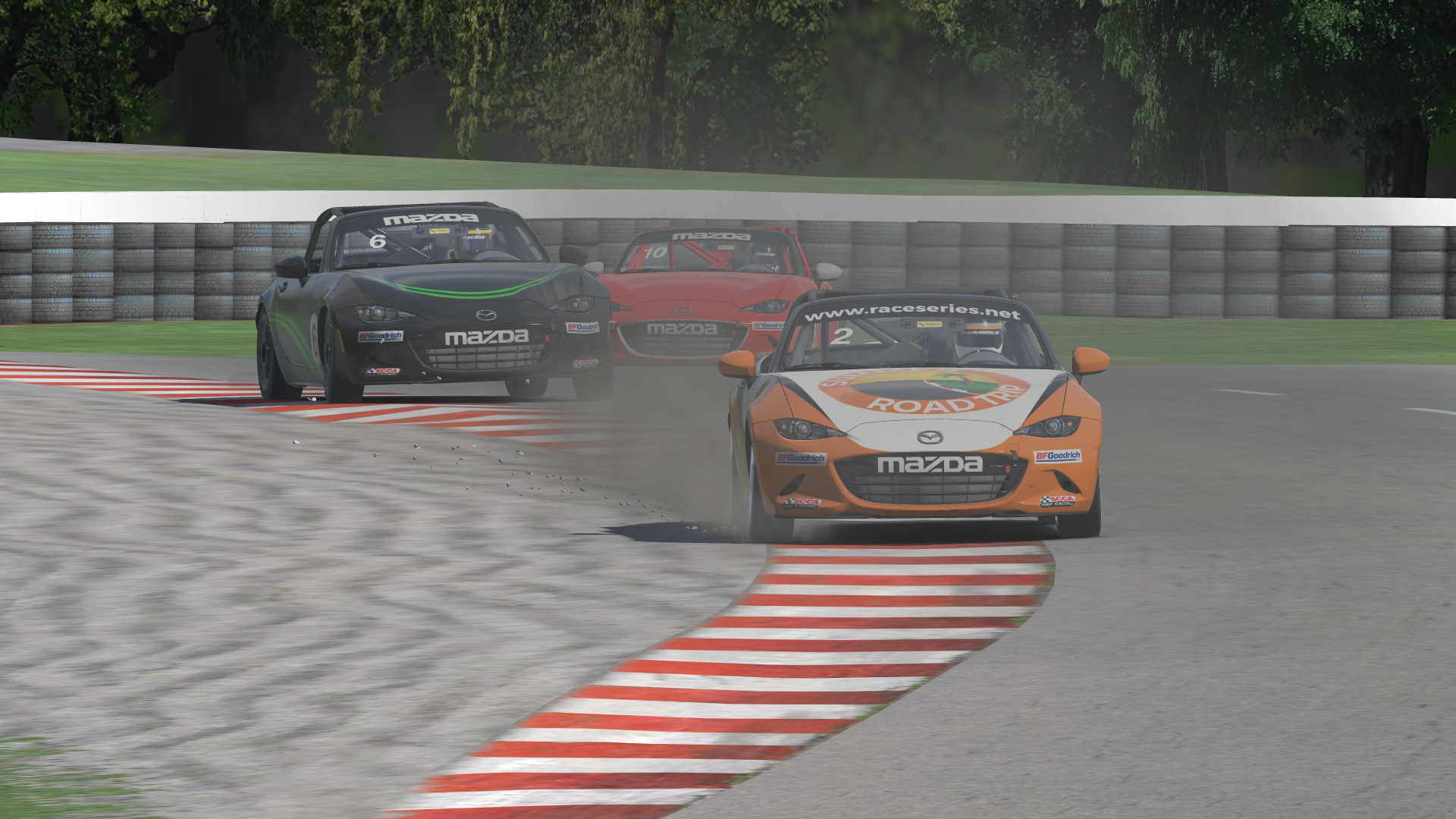
Using all of the track and them some to gain every advantage possible.
As I discovered in my races, that competition can cost big chunks of safety rating. In my first race, only one driver gained safety rating, and in either race, only one driver went incident-free. While this car isn’t inherently unsafe, pushing it to — and sometimes, just over — the limit in search of speed makes it awfully easy to rack up incident points.
In that sense, John Henry’s words still ring true: For rookie drivers, running cleanly enough to get out of the rookie class is still the number one goal. And with a relatively forgiving car that’s ideal for learning the basics of driving and racing, that goal is absolutely within reach.
But thanks to the Mazda’s fun factor, full fields, incentives for top drivers, and a schedule that won’t feel stale after two weeks, the rookie series isn’t just for rookies any more.